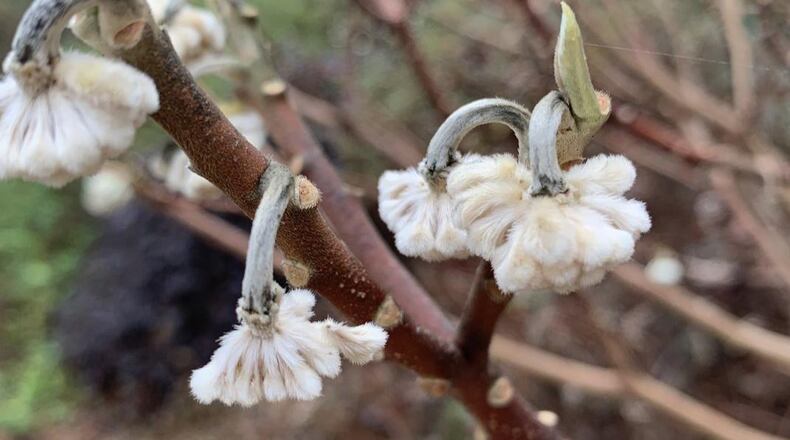Q: My paperbush (Edgeworthia) flowers were very small this year. I think the cause was the long, hot, dry summer at a time when they usually set their flowers for winter.Leslie Swain, email
A: I think the problem was caused by cold, not drought. On Nov. 11-12, 2019, temperatures dropped suddenly down to 25 degrees. A couple of weeks afterward, a radio caller described the flowers on her paperbush as being crumbly and falling readily when touched. I saw the same thing on my own plant. As the weeks have passed, I have seen most of my flowers disappear. My guess is that our plants did not have enough time to acclimate to the sudden November cold and that caused the effects we are seeing now.
Q: Are the increased soil temperatures the last few weeks disrupting the schedule for applying preemergent to lawns?Mike Pesak, email
A: You are very observant! Crabgrass seedlings emerge when soil temperatures hit 55 degrees for a few days and the trend is higher. In past years, this has happened in late February and early March. My usual recommendation is to put out preemergent in early March, but there's nothing wrong with applying it in mid-February. The chemicals that keep seeds from germinating are broken down by soil organisms, which are not very active in cold soil.
Q: We enjoyed two asparagus spears from our plant back in January. How rare is this?David Rush, Buckhead
A: Soil temperature is the main trigger for asparagus spear production. Perhaps a root was growing shallowly and became warm enough to send up a couple of spears. Deeper roots will wait for more consistent warm soil temperatures in early spring before they sprout anything more.
Q: I have some loblolly pine acreage with an easement road down the middle. I'm considering planting black walnut trees on both sides of the road for my grandchildren to sell the lumber and for wildlife. How far should the trees be separated from the pines to avoid damage due to juglone produced by walnut tree roots?Charlie Steck, Pike County
A: Contrary to what I and other garden experts have written previously, it turns out that walnut trees are not always allelopathic to other plants. For every mention that black walnut is harmful to a particular plant, there seems to be another observation that no harm was done to that plant by a nearby walnut tree. In a laboratory, juglone was shown to inhibit some plants, but laboratory tests are not nearly the same as landscape conditions. Some species of pine have been demonstrated to be harmed by walnut tree roots. So your safest bet is to have the walnuts around 30 feet away from your pine trees.
Listen to Walter Reeves’ garden commentary Saturday mornings on 95.5 WSB. Visit his website, www.walterreeves.com, follow him on Twitter @walterreeves, on Pinterest, or join his Facebook Fan Page at bit.ly/georgiagardener for more garden tips.
About the Author
The Latest
Featured

